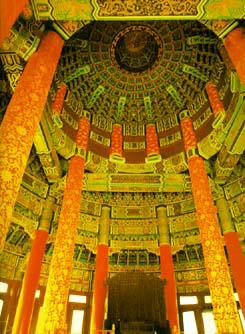About 2km southeast of the Forbidden City towers Tian Tan, or the Temple of Heaven, where dynastic rulers in China used to worship the heaven. The temple plus subsidiary buildings and a surrounding garden covers an area five times the size of the Forbidden City. As Chinese emperors called themselves Tianzi, or the son of heaven, they had to cede supremacy to the heaven in terms of abiding.
Chinese emperors had many other gods to worship apart from the god of heaven, including the gods of earth, water and war. They also worshipped their ancestors. As a result, religious activities were an important part of their busy work schedule. Temples of various kinds are scattered in Beijing. The best-known are the Temple of Heaven in the south, the Temple of Earth in the north, the Temple of Sun in the east, and the Temple of the Moon in the west. The Temple of Heaven is the grandest of them all.
The Temple of Heaven was built on a central axis. At the southern extreme is a square wall representing the earth, and at the northern extreme is a semicircular wall representing the heaven. The design was based on the primitive belief of "round heaven and square earth."
The Temple of Heaven has an area of 273 hectares with a layout in two squares one inside the other. Two walls divide the ground into the outer and inner parts. The outer wall is 6,416 meters long and the inner wall is 3,292 meters long. The northern part of the outer and inner walls is a semicircle and the southern part of them is square, declining from north to south to symbolize the traditional belief that Heaven was high and round and the earth was low and rectangular.
The Temple of Heaven is an outstanding representative of Chinese traditional architecture for its clever design and harmonious colors.

Also known as Qigu Hall, it was the spot where the emperor of the Ming and Qing dynasties prayed for good harvest in spring. The umbrella-like structure of three tiers stands on a six-meter-high white marble circular terrace and is 32 meters high and 24.2 meters around at the base.

Aerial view

The pillars inside the hall all have a meaning: the four in the inner circle represent the four seasons of the year; the 12 pillars in the middle circle represent 12 months of the year and the 12 pillars in the couter circle represent 12 time periods of the day. The Leigong Pillar under the center of the ceiling means the absolute power of the emperor.
Temple of Heaven appears on the following banknote(s):
| |